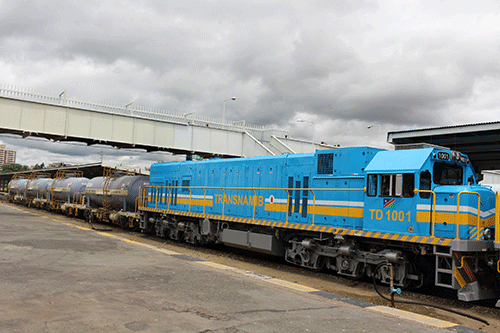TransNamib acting CEO Webster Gonzo on Tuesday said only about 24% of the current rail network is in good working order.
“Most of the network – of about 76% – is not at the level required to run an efficient rail service. In order for us to move more cargo safely and efficiently, much more investment is required,” he said while hosting small and medium enterprises (SMEs) at TransNamib facilities.
TransNamib, in conjunction with the Namibia Chamber of Commerce and Industry (NCCI), hosted about 40 SMEs on its premises, where it gave the SMEs a tour of its facilities, an overview of its operations and plans, with a focus on its procurement process, requirements and planned activities.
The CEO added that through the works ministry, government has committed itself to supporting the development of rail infrastructure in the country.
Government has already invested N$3 billion in the Walvis Bay to Kraanzberg line, which is now completed.
The next phase, according to Gonzo, is the Kraanzberg to Otjiwarongo, which is set to begin later this year for about four years to the tune of N$4 billion.
The next phase will be from Otjiwarongo to Tsumeb, worth around N$3 billion and then Otavi to Grootfontein, which will also be just under N$3 billion.
In the past decade, the Namibian government has invested over N$3 billion into railway infrastructure upgrades.
During the 2018/2019 financial year, TransNamib generated revenue of N$517 million, which is an increase of 10.5% in revenue year-on-year.
Despite the challenge of rolling stock, TransNamib managed to attain its highest percentage increase in revenue in over a decade.
Unfortunately, Gonzo noted, the progress was derailed by the Covid-19 pandemic and its impact on its revenue.
The business is also in the final stages of gaining approval for the new integrated strategic business plan (ISBP) for the next five years, as the current ISBP concluded with the end of the financial year at the end of March 2023.
Gonzo shared that TransNamib is currently running up to six trains a day up to Tsumeb, with the vision of increasing that capacity once all works have been completed on this section.
“Rail is an economic enabler, moving cargo freight at volumes that are unmatched. This not only drives the prices of consumer goods down but brings relief to Namibian roads in terms of the wear and tear on the road infrastructure, as well as allowing for safer roads. TransNamib’s road-to-rail strategy will reduce the number of trucks on the road, lowering the number of road accidents and reducing traffic congestion,” he emphasised.
The CEO noted that investing in rail also has a longer return on investment, as the lifespan of rail is about 100 years, compared to 21 years for road.
Namibia has the potential to be a logistics hub of note at regional and international levels. Its world-class ports in Walvis Bay and Lüderitz are strategically located and supported by well-maintained road infrastructure that extends across Namibia into the region.
Additionally, the Port of Walvis Bay is closer to the North American and European markets than any of South Africa’s Ports.
“The final element to positioning Namibia as the preferred logistics hub in southern Africa remains rail. We believe in the potential of rail to position Namibia as a leading logistics hub,” said Gonzo.
In November 2018, TransNamib and Botswana Railways (BR) signed an agreement that will culminate in the development and operation of a container terminal in Gobabis.
Furthermore, this agreement serves as a short to medium-term partnership to connect the two rail companies via a rail and road intermodal service between Namibia and Botswana.
The intermodal linkage from Walvis Bay to Gobabis will, therefore, reduce the road transportation return trip by about 1 200km.
– mndjavera@nepc.com.na


